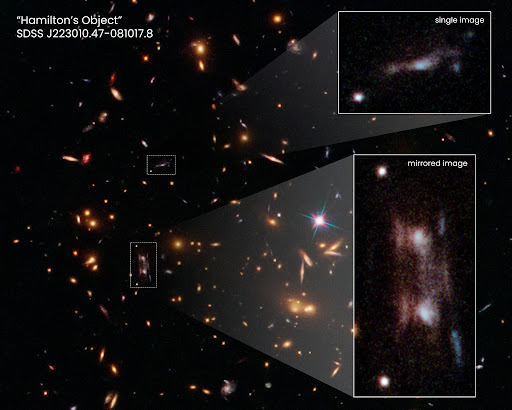Hamilton’s Object
Astronomers have discovered an unusual gravitational lensing configuration called the “Hamilton Object”, which consists of two images of a spiral, clumpy background galaxy bulging in a folded configuration and a third resolved image of the same spiral galaxy that together form a spike configuration.
Highlights
In images from the ESA/NASA Hubble Space Telescope, Shawnee State University astronomer Timothy Hamilton and his colleagues found that the immense gravity of a cluster of intermediate and uncategorized galaxies in the foreground distorts space, enlarges the image, illuminates and stretches a distant Galaxy which is behind the cluster.
Although the Hubble investigation reveals many of these funhouse mirror distortions caused by gravitational lenses, this object was especially confusing. In this case, the exact alignment between the galaxy in the foreground and a group of galaxies in the background creates two enlarged copies of the same image of a distant galaxy.
This rare phenomenon occurs because the background galaxy is spread by a wave in the structure of space. These ripples are areas of maximum magnification which are caused by the gravity of dense amounts of what is called as dark matter. Two mirror images are created along with a third image which can then be seen from the side when light from a distant galaxy penetrates the cluster along these ripples.
This rare phenomenon was not known when the astronomer discovered strange linear features in the year 2013. While looking through images of quasars, he discovered parallel lines and reflected images. The astronomers hadn’t seen anything like and so they embarked on a quest to solve the mystery of these tantalizing straight lines, which they later named the Hamilton object in honor of their discoverer.


